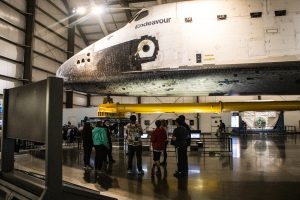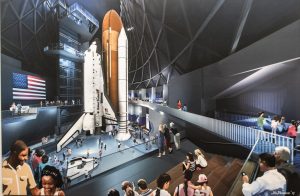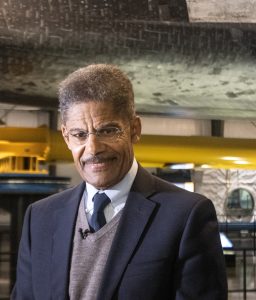- Slug: BC-CNS Space Shuttle Move, 620 words.
- 3 photos and captions below.
By Fernanda Galan Martinez
Cronkite News
LOS ANGELES – After 122 million miles in space, the shuttle Endeavour is about to embark on a new mission. This time, its journey will be measured in feet.
The retired shuttle’s final frontier will be a new building, the Samuel Oschin Air and Space Center, next door to the California Science Center, where it’s displayed horizontally. The spaceship will be displayed upright, in launch position, with its enormous orange fuel tank appearing to be attached to its belly and two white booster rockets on either side and a launch gantry to view the shuttle at every viewpoint.
“I have a feeling that once people see that thing upright, it’s going to be absolutely stunning,” said Kenneth Phillips, curator of aerospace science at the California Science Center. “We’ll be able to visit it from every level from the point at which the solid-rocket boosters are anchored to the concrete all the way up to a glass platform.”
The exhibit will put the shuttle’s key components all in one place. Mark Kelly, the Arizona Democrat just who just won another term in the U.S. Senate, was the commander for Endeavour’s last mission.The Pima Air and Space Museum in Tucson, received the Thiokol space shuttle solid rocket booster from the California Science center in 2016.
Endeavour – the fifth and final space shuttle to be built – has been in Los Angeles for a decade, positioned as if it were flying in space or soaring through the atmosphere on its way to touchdown. Since going on display in 2012, it has attracted visitors from around the world, skyrocketing attendance at the California Science Center from 1.2 million to 2.4 million.
Endeavour started its first orbital mission – the first of 25 – in 1992.
Perhaps the most grueling of its adventures came after it was retired. Endeavour was flown to Los Angeles International Airport riding piggyback on a NASA Boeing 747, then embarked on an arduous 12-mile journey across the city. The shuttle was towed through the streets after workers cleared protruding utility poles or street lights and trees were clipped to accommodate its 78-foot wingspan.
As harrowing as that trip was, the move next door won’t be any easier for Endeavour.
Phillips said the shuttle will be lifted 350 feet using a sling attached to a crane. The crane will rotate the spacecraft, then mate it to the fuel tank and rocket boosters. When completed, it will stand 200 feet tall.
When the move is completed in 2026, visitors will be able to view the shuttle from virtually every level. Of course, viewing positions are all relative when it comes to the shuttle.
“That’s why the vehicle is so special to all of us – once you’re in space, everything turns upside down,” Phillips said. “Everything is different. There is no up, there is no down. You’re orbiting the Earth. So you get 16 sunrises and 16 sunsets in a single day.”
At least one young visitor to the science center was excited to see the shuttle appear to be shooting for the stars.
“I think it will be good,” said Declan Eliason, who came with his dad to see the shuttle on his ninth birthday. “Now you can’t see the top. So when it’s upright, you will be able to see it. It will probably be better.”
His father, Tyler Eliason, thinks the space shuttle is inspiring to the younger generations and appreciates that it will be staged in its original position.
The Samuel Oschin Air and Space Center is meant to inspire young minds, and get them thinking about science and space exploration.
“It shows how people come together with machines,” Phillips said, “how people can create things that are much more, that are large, much bigger than themselves, and that are capable of taking us literally from the surface of the earth.”
For more stories from Cronkite News, visit cronkitenews.azpbs.org.
^__=


